SUSPENDED ANIMATION #249
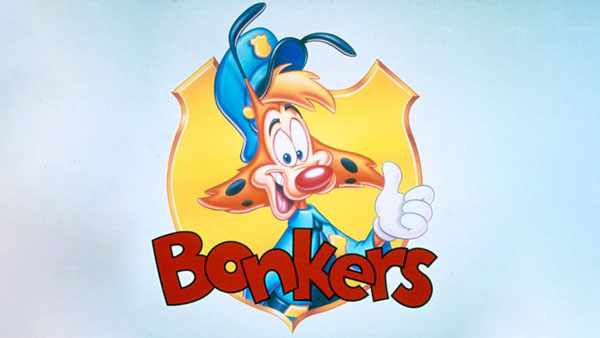
Bonkers D. Bobcat was an anthropomorphic spotted orange bobcat with a red clown-like nose.
During his short life span from 1992 to 1995, he physically changed his appearance (large-knobbed ears and spotted tail with a white tip and brown colored spots on his fur morphed into smaller ears with black spots and a striped tail among other changes including his blue eyes becoming black), changed his supporting cast of characters, and more because, well, he was just bonkers.
By 1992, the relationship between the Walt Disney Company and Steven Spielberg’s Amblin entertainment company had soured almost completely over their joint ownership Roger Rabbit and his supporting cast. The Disney solution was to create its own loveable, wacky animated character in the spirit of Roger Rabbit.
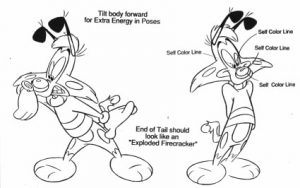 The plan was to produce the standard 65 half hour episodes to be included in the popular two hour Disney Afternoon syndicated cartoon block of cartoons that was broken up into four separate series, one of which rotated out each year with a new installment taking its place. Reruns would be shown on the Disney Channel.
The plan was to produce the standard 65 half hour episodes to be included in the popular two hour Disney Afternoon syndicated cartoon block of cartoons that was broken up into four separate series, one of which rotated out each year with a new installment taking its place. Reruns would be shown on the Disney Channel.
Bonkers D. Bobcat was an animated star of WackyToon Studios and was designed to be as frantic and extreme as Roger Rabbit in the style reminiscent of the classic Tex Avery directed cartoons of the 1940s.
The animated short Petal to the Metal was released on August 7, 1992 to theaters to accompanying the live action Touchstone feature film 3 Ninjas.
Directed by David Block, this eight minute animated cartoon was a production of Walt Disney Television Animation and was meant to introduce the new character of Bonkers D. Bobcat (voiced by Jim Cummings) to audiences before his television series. While the original pre-production work took place in California, the animation was done in France. Bonkers is a delivery boy who runs into non-stop catastrophes trying to deliver flowers to starlet Fawn Deer within his five minute delivery deadline or lose his job.
The proposed series featuring Bonkers for the Disney Afternoon block ran into several difficulties and would not be ready in time. One of those problems was that the animation had been outsourced to ten artists at Toon City Animation Studio, an independent studio in Manila, because it was cheaper than doing it in the United States and it was their first project for Disney.

CEO Michael Eisner had purchased the rights to a popular Belgian comic strip featuring an unusual creature called the Marsupilami. To take advantage of this asset, it was decided to produce an interim show of twelve episodes entitled Raw Toonage for Saturday morning.
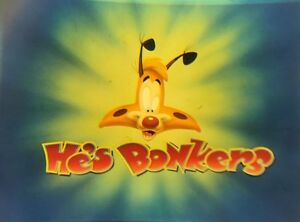 The half hour that debuted September 12, 1992 on CBS included a short cartoon of Marsupilami, a segment called Totally Tasteless Video, story edited by Tom MInton, to satirize popular culture like movie trailers, Magnum P.I., chicken exorcism and more as well as a segment entitled He’s Bonkers that were supposedly episodes from WackyToon Studios to give more credibility to the fact that Bonkers was an actual animated cartoon star. Larry Latham produced and directed these He’s Bonkers shorts.
The half hour that debuted September 12, 1992 on CBS included a short cartoon of Marsupilami, a segment called Totally Tasteless Video, story edited by Tom MInton, to satirize popular culture like movie trailers, Magnum P.I., chicken exorcism and more as well as a segment entitled He’s Bonkers that were supposedly episodes from WackyToon Studios to give more credibility to the fact that Bonkers was an actual animated cartoon star. Larry Latham produced and directed these He’s Bonkers shorts.
Going Bonkers was a two-hour television special, airing September 3, 1993. Directed by Robert Taylor (who had been put in charge of the television series), it was meant to introduce the new half hour cartoon series and how Bonkers went from cartoon star to rookie cop.
Using animation from the theatrical short, the show begins with the studio filming it. The head of the WackyToon Studios, W. W. Wacky, comes in and fires everyone. It turns out that a rival studio has replaced WackyToon Studios as the top animation studio with its The Bicep Bill Squad series. The studio boss will not tolerate being “number two”. Bonkers and his friends Jitters A. Dog, Fawn Deer, and arch-enemy Grumbles Grizzly must now find new jobs.
Through sheer dumb luck, Bonkers unwittingly comes to the aid of Donald Duck and, at the same time, helps veteran human cop detective Lucky Piquel (also voiced by Jim Cummings) arrest the mugger who attacked Donald.
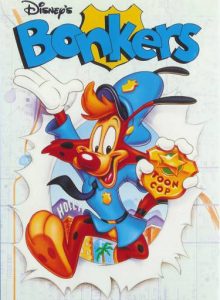 This heroic act results in a Citizen of Valor award and lands Bonkers a new job as a rookie on the Tinseltown Police Force, where he works with the reluctant Piquel in the newly-formed Toon Division to handle crimes involving toons. Ironically, Bonkers familiarity with Toons and their behavior proves to be very helpful in solving crimes.
This heroic act results in a Citizen of Valor award and lands Bonkers a new job as a rookie on the Tinseltown Police Force, where he works with the reluctant Piquel in the newly-formed Toon Division to handle crimes involving toons. Ironically, Bonkers familiarity with Toons and their behavior proves to be very helpful in solving crimes.
Basically the mismatched partnership was meant to suggest the Lethal Weapon (1987) movies with a sedate, out-of-shape older officer with a family (wife and daughter) teamed with a much more manic one who acts crazy.
Bonkers was given a new Toonish supporting cast including Fall Apart Rabbit (who literally falls apart when startled or excited) and objects like Toots the bulb horn that behaved like a pet dog, a police light wearing a Chevalier boater hat, spats and tap shoes and spouts bad vaudeville jokes and Broderick (a tribute to actor Broderick Crawford’s portrayal of a policeman on television) the police radio.
Originally, the series was to team Bonkers with the blonde policewoman Sergeant Miranda Wright (a take-off on the term “Miranda Rights” that have to be read to suspects when arrested) and voiced by singer Karla DeVito, wife of Robby “voice of Disney’s The Beast” Benson who had been filming the animated feature around the same time. It was this teaming of a female policewoman with a non-human partner that reportedly inspired a similar teaming in the series Gargoyles.
However, when the first episodes featuring Miranda came back from animation overseas, Disney did not care for them or the direction of the series was taking so it was given to a different team and reworked.
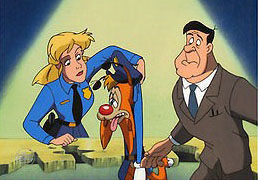 Bonkers was now teamed with Piquel for 42 episodes whereupon Piquel got promoted to an FBI post in Washington, D.C. when he helped an agent apprehend a bomber and Bonkers was re-assigned to the less abrasive Miranda who had been shown in the Piquel episodes to be the secretary to Chief Kanifky and had been finally promoted to policewoman as she always wanted.
Bonkers was now teamed with Piquel for 42 episodes whereupon Piquel got promoted to an FBI post in Washington, D.C. when he helped an agent apprehend a bomber and Bonkers was re-assigned to the less abrasive Miranda who had been shown in the Piquel episodes to be the secretary to Chief Kanifky and had been finally promoted to policewoman as she always wanted.
This change was accomplished in an episode entitled New Partners On the Block that aired October 1993 and then followed by the 19 original episodes that had been made with Miranda. Piquel took along with him to Washington Fall Apart Rabbit, the toon horn, radio and light so it would help explain why they were not in the Miranda episodes that had been animated before those characters were created.
Bonkers ran from September 4th, 1993 to February 23, 1994 and then in reruns on the Disney Channel through 1995. Bonkers did appear in stories in the 1994 Disney Afternoon Comic Book published by Marvel as well as issues of Disney Adventures magazine.
 Burger King also issued a Kids’ Meal toy of a two inch tall Bonkers PVC figure in uniform as well as a set of five Crash Apart Cars driven by the characters. There was also a Super Nintendo and a Sega Genesis game with the character. In the first, he needs to find three lost Toontown treasures and in the second capture four criminals to get the Employee of the Month award.
Burger King also issued a Kids’ Meal toy of a two inch tall Bonkers PVC figure in uniform as well as a set of five Crash Apart Cars driven by the characters. There was also a Super Nintendo and a Sega Genesis game with the character. In the first, he needs to find three lost Toontown treasures and in the second capture four criminals to get the Employee of the Month award.
There was even a costumed character Bonkers who made appearances at Disneyland and Walt Disney World. He also performed in the Magic Kingdom show at Mickey’s Starland in 1993-1994 as did other Disney Afternoon characters.
He never got the attention or affection given to Roger Rabbit and like many Disney characters, he simply disappeared as the years passed.


 Jim Korkis is an internationally respected animation historian who in recent years has devoted his attention to the many worlds of Disney. He was a columnist for a variety of animation magazines. With his former writing partner, John Cawley, he authored several animation related books including The Encyclopedia of Cartoon Superstars, How to Create Animation, Cartoon Confidential and Get Animated’s Animation Art Buyer’s Guide. He taught animation classes at the Disney Institute in Florida as well as instructing classes on acting and animation history for Disney Feature Animation: Florida.
Jim Korkis is an internationally respected animation historian who in recent years has devoted his attention to the many worlds of Disney. He was a columnist for a variety of animation magazines. With his former writing partner, John Cawley, he authored several animation related books including The Encyclopedia of Cartoon Superstars, How to Create Animation, Cartoon Confidential and Get Animated’s Animation Art Buyer’s Guide. He taught animation classes at the Disney Institute in Florida as well as instructing classes on acting and animation history for Disney Feature Animation: Florida.




















































I remember this show well. It had a few fun ideas, but there were few standout episodes. One had Mickey Mouse get kidnapped and replaced with a former child actor in a bad Mickey costume; it was the first time Disney’s TV division used Mickey, and they treated him much like Jesus Christ was on Ben-Hur, never showing his face and only referring to him as “the Mouse”. All in all it was okay, but it lacked the strong narrative of other shows like Duck Tales and Gummi Bears.
As I recall, Animaniacs did a lot of, as the kids today call it, “throwing shade” at Bonkers. I believe it was because Bonkers was the working titile and they were a little miffed that Disney took it. The disagreement between Amblin and Disney over Roger Rabbit may have also contributed to the rivalry.
I was 10 years old then. Every kid I knew talked about “Animaniacs.” No one mentioned “Bonkers,” even in passing.
Eventually, Bonkers was namedropped in one episode of “Animaniacs”, the one that introduced Slappy Squirrel to the series. Right at the beginning of that segment, after Skippy enters the house and explains that his sudden burst of energy resulted from consuming so much sugary cereal, Slappy laughs and says,”No wonder you love that Bonkers show!”
Bonkers may have been put out of commission in the public consciousness, but like most of Disney’s other shows of the time period, he ended up having a spot on Toon Disney, which along with Nickelodeon, Cartoon Network, and later Kids’ WB, was one of my go-to places for cartoons growing up. Toon Disney certainly liked to promote Bonkers in its early days (which makes sense given the “toon” theme the network liked to hammer in during that time). I even remember them running a 24-hour Bonkers marathon at one point. I don’t even think I slept that day; I actually saw the tail-end of the marathon before it going back to regular programming with Wild West C.O.W. Boys of Moo Mesa at (I think) 6 a.m. Eventually, though, Disney had newer shows to promote (particularly House of Mouse, which would more or less become Toon Disney’s flagship series until the switch to Disney XD), and by the time it left the regular schedule in 2004, it had already been relegated to a late night timeslot, acting as a lead-in to Garfield and Friends (which would itself last until 2006 when Jetix started airing all night).
I always loved Bonkers, but didn’t realize there was so much history to the character. Thanks for sharing!
All this, and you don’t even mention that Bonkers is now legally available again for the first time in many years on Disney’s new streaming service Disney+?
Wow, this really takes me back. I was eight years old in 1993 and loved classic cartoons, so this was right up my alley. I still vividly remember the ad campaign in children’s magazines promoting the show’s debut as well as the premiere, which I believe aired in prime time. For years I tried to track down the music video that wrapped up the debut, and finally found it on Youtube. “Bonkers: He’s on the beat!”
I watched the show as often as I could, and can still recall many episodes. I found it fascinating when I learned later how the show’s planned structure was originally rather different. Would they even have created the Lucky character if the shows with Miranda had been up to scratch to begin with? Lucky was a much more memorable character.
Thanks for the great trip down memory lane, Jim!
Does anyone know anything about the Austrlaian Disney animators who worked on this show and others from this era? I’m trying to match names to animation and so far my research has ID’d Adam Murphy and Steven Trenbirth with relative certainty. I’m still trying to figure out what Warwick Gilbert and Andrew Collins did for the TV shows. Their character animation credits for the later direct to video movies havent been of much help because it’s so watered down. Anyone?
And what the heck, I might as well plug my podcast. I co-host an episode by episode Darkwing Duck cast called “The St Canard Files”, if anyone is interested.
Supposedly, some (all?) of these scenes are by Kevin Peaty: https://twitter.com/johnnygoransson/status/1083868507526311936 . Fantastic work.
Great article, Jim! I’ve always loved Bonkers’ design.
One minor trivia tidbit: Bonkers also had a Game Gear game called Bonkers Wax Up!. It was also ported to the Master System in Brazil, if I recall correctly.
A few remarks:
– Raw Toonage was not an interim show for Marsupilami. The company planned a segmented show years before they licensed Marsupilami. When they finally bought the rights to Marsupilami, they were still considering if they should produce a 13 episode or a 65 episode run for the character. The court case made it clear that Disney didn’t want to make the effort to support Marsupilami with marketing because it would have had an impact on their own properties. Disney didn’t know what direction to take with the character and they had to put him somewhere. Raw Toonage lent itself to short subjects, and that was basically the only thing that Disney’s Marsupilami was good for.
– Director/producer Bob Taylor was only in charge of the second part of production, the Piquel episodes.
– The earlier Miranda episodes that needed to be reworked were mainly done by Disney Television Animation Japan and Sunwoo. Toon City would work on the later Piquel episodes, after the major production delay. The delays afterwards were self-inflicted by Disney and Bob Taylor for wanting to air the Piquel episodes before the already finished Miranda Wright episodes. (It is important to note that Bob Taylor took the series over after the Miranda episodes were being fixed by temporary producers Buzz Potemkin and Gordon Kent. The show was getting pushed back a year anyway, but Taylor was adamant on changing the show and its dynamic, so he had to reinvent the whole thing.)
I’ve been looking for the original stereo recording of “Bonkers is on the Beat”, which was featured after the pilot.
“Bonkers” was ill served by being part of the early ’90s “Disney Afternoon” package so it got lost in the morass of “Ducktales” and “Tale Spin” and “Darkwing Duck” and “Goof Troop” and a couple others I forget. And also by not being very good.
Bonkers was ok, passable at best.
If there was one problem i saw through the show is a simple word… Mean-spirited.
The main character is basically a wonky juggling act between a try-hard Roger Rabbit clone and a toned down Darkwing Duck (yes seriously, that’s how Bonkers came off to me)
Each episode is mean spirited in one way or another whether towards the main character, Bonker’s human partner, the daughter of said partner or any toon (even an off camera mickey) in Toontown.
The humor is mainly hit and miss but mostly miss.
When Bonkers came out, The writing was indeed on the wall for Disney Afternoon because of home media, blocks like Fox Kids and Kids WB! and of course.. cable channels like Nick and Cartoon Network.
Didn’t mean syndication is dead though, there were shows that do appear in syndication tho confusedly thought to be part of the main network schedule like Monster Rancher, The Lionhearts, Masked Rider (Saban’s bastardized adaptation of Kamen Rider Black RX), VR Troopers and many others.
I am the uploader of Disney’s Marsupilami since 2008. I guess I think Marsupilami was way better than Bonkers. And I think I loved him when he speaks and does not only say Houba! To my mind, Marsupilami is way better than Bonkers! I hope to get the show on Disney+ as well.
Wow, this really takes me back. I always watched this cartoon when I was 8.